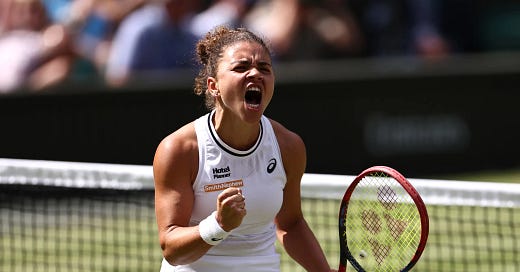The meteoric rise of Jasmine Paolini
Forehand potency, net play, +1 opportunities, the sum of small improvements
It’s been a bumper 2024 for Jasmine Paolini. Over the course of year, she has established herself inside the top ten of the WTA Tour and catapulted herself into competition with the best players in the world – no mean feat for a player who, before 2024, had not progressed beyond the second round of a Grand Slam tournament.
The tennis world really began to take notice of the small-in-stature, but big-in-personality Paolini after she reached back-to-back finals at the French Open and Wimbledon, adding to a maiden WTA 1000 title in Dubai in February.
Now late in the year, and ranked number 4 in the world, Paolini has battled admirably in the WTA Finals and is a strong chance to be crowned the WTA’s most improved player.
The big question is: what’s been behind the 28-year-old’s breakout year?
Paolini’s progression
Paolini, unsurprisingly, has won a lot more matches in 2024 than in previous years. In fact, from 2023 to 2024, Paolini increased her winning percentage from 52% to 68% – this 16-percentage point increase was the second largest on the WTA tour (for those with more than 50 matches played), behind only Danielle Collins. This boost in winning percentage brings Paolini much closer to her WTA finals peers:
Paolini’s performances in grand slams this year probably sums up her improvement best – not only did she make the final at both the French Open and Wimbledon (the first to do so since Serena Williams in 2016), she also reached maiden fourth round appearances at the Australian Open and the US Open.
Forehand potency
One of the main driving factors of Paolini’s rise in 2024 has been an increase in her forehand potency (FHP).
FHP (or BHP for backhands) is a metric devised by Jeff Sackmann, creator of Tennis Abstract – which quantifies the net effect of a forehand or backhand for every 100 of these groundstrokes. It is calculated as follows: +1 point for a winner or an opponent’s forced error, +0.5 for setting up a winner or opponent error on the next shot, -0.5 for setting up an opponent’s winner on the next shot, and -1 for an unforced error. This is then divided by the total number of forehands (or backhands) and multiplied by 100.
Over her career, Paolini has floated somewhere close to average in both her FHP and BHP – she is positioned near the dotted lines in the chart below, which represent the averages. Paolini’s FHP over her career is around 6.7, which equates to around +4.5 points per 100 forehands:1
However, in 2024, Paolini’s FHP potency jumped to 9.9 – equating to roughly +6.6 points per 100 forehands. For reference, Sabalenka’s forehand – which is one of the strongest forehands on the WTA tour, reached an FHP of 13.1 (+8.7 points per 100 forehands) in 2024.
This increase in forehand potency can be seen in the below chart – compared to her career average in FHP, Paolini’s forehand potency in 2024 is now well above average, and she has consequently shifted much further to the right. In fact, her forehand has improved so much, that among her fellow WTA finalists, only Swiatek and Sabalenka boast a higher FHP in 2024.
Among players with at least 10 charted matches in 2024, Paolini’s improvement in her forehand potency (FHP) per 100 forehands was the third largest. Among her WTA finals peers, it was the largest:
There’s been plenty of evidence of Paolini’s improved forehand in 2024. She used it to great effect against Emma Navarro in the quarter-final of Wimbledon, which was one of her most dominant forehand performances of the year.
A couple of examples from her match against Navarro:
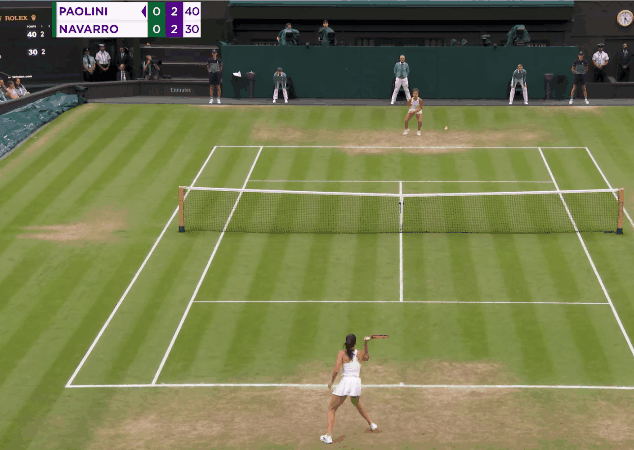
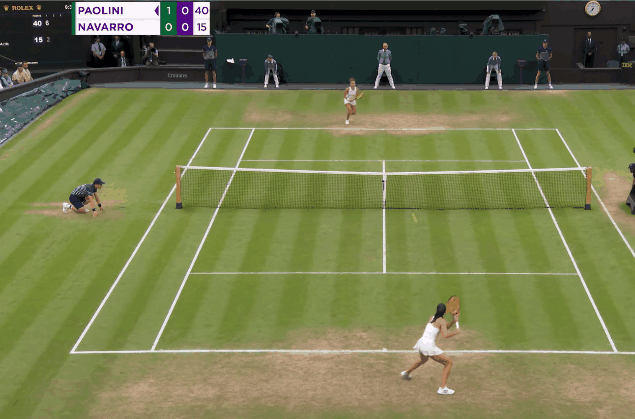
Efficient net play and court movement
An underrated aspect of Paolini’s game is her net play – and like her forehand, is an aspect of her game that she has improved upon in 2024 relative to her career averages.
Over her career, Paolini has gone to the net at an above-average rate, with around 8.5% of her points being played at the net. She also wins just over 70% of the points she plays at the net – a rate that is comparable with some of the best players on tour:
However, in 2024, Paolini played 9.6% of her points at the net (+1.1ppt compared to her career) and winning 71% of her net points (+1ppt).
The increase in net points played puts Paolini at the pointy end of the tour, as can be seen in the below chart. Among those with 10 or more charted matches in 2024, her 9.6% of points played at the net is only bettered by Karolina Muchova (15.4%) and Leylah Fernandez (12.6%).
Paolini’s more frequent ventures forward in 2024 have also been more successful – she has won 71.2% of her points at the net – putting her once again in the company of the top players on tour.
As a result of these improvements, Paolini has once again shifted herself further to the right of the chart (and slightly higher), cementing her place in the top right quarter of the chart below:
Some of this improvement at the net in 2024 may be down to the productive doubles partnership she has formed with her Italian compatriot, Sara Errani. The pair began playing doubles with each other in 2023 and have enjoyed considerable success together, not least securing a gold medal at the Paris Olympics this year.
Paolini has spoken about the benefits of playing doubles with Errani, and what she has learned from her:
“I think I started to play better at the end of last year and I think doubles helped me a lot… I would say the tactical part of the game, that’s the most I’m trying to learn from her… So tactically is where she helped me the most.”
Add in Paolini’s very strong court movement – she is one of the fastest movers on the tour and is able to cover the court extremely well – and it means that despite her height disadvantage, Paolini is a very well-rounded player at the net.
Returning once again to her match against Navarro in the Wimbledon quarter-final, Paolini won an impressive 16/17 (94%) of net points on the day. A couple of examples below:
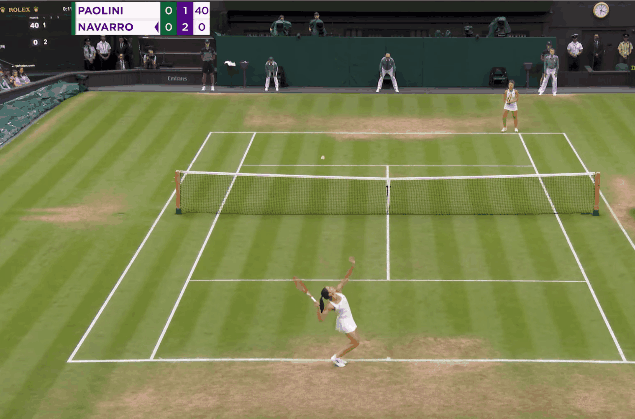
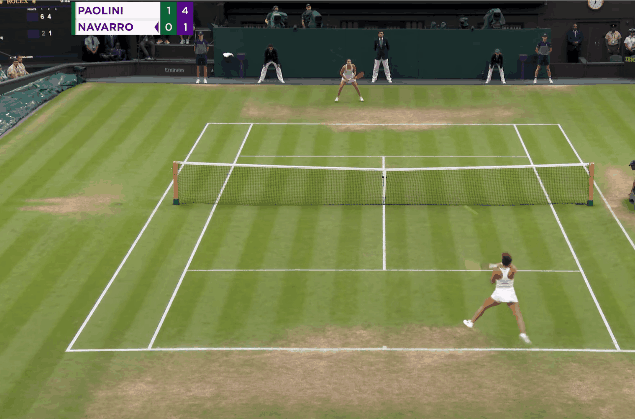
First serves and +1’s
Another source of improvement from Paolini in 2024 has been her ability to generate, and win, more +1 points from her first serve.
Paolini is not the strongest server on tour – she tends to fall below average in most serving metrics. However, in 2024, she increased the proportion of first service points won in 3 shots or less from 31% to 35% - a 10% increase.
This can mean one of two things: either Paolini is hitting a greater number of unreturned serves, or she is generating more +1 opportunities. It appears to be the latter. Paolini’s unreturned first serve percentage only increased from 21% to 22% in 2024, suggesting that the increase in first service points won in 3 shots or less is coming from an increase in +1 winners. The ability to generate +1 opportunities on serve is a valuable asset, especially for someone like Paolini, who does not have a wholly damaging serve.
For some perspective, Paolini’s 35% of points won in less than 3 points is still some way below the stronger servers on tour – Rybakina sits at 55%, Sabalenka at 50% and Swiatek at 42%, but it is a valuable improvement all the same:
Food for thought – drop shot success
A fascinating insight from Jeff Sackmann in his most recent article – Paolini has been gaining a strong advantage in games where she hits a drop shot. She only hits a drop shot on around 1.1% of points, which is near the lower-end of the tour – and so while it may not be a huge contributing factor to her improvements in 2024, it’s worth pointing out all the same.
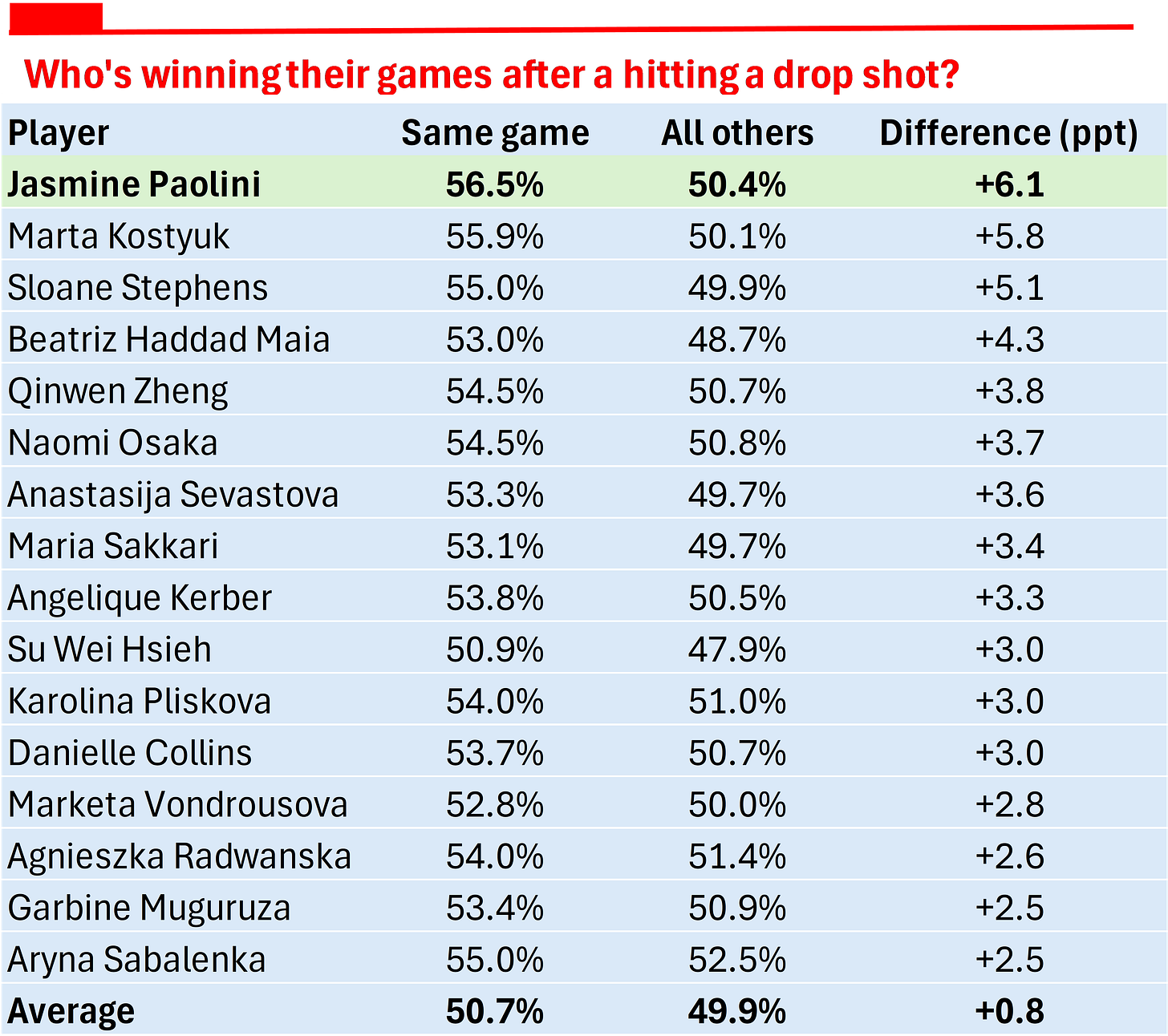
Final thoughts
Paolini’s come-from-the-clouds improvement in 2024 has been one of the highlights of the tennis year. She has made subtle, but important, improvements to many aspects of her game – the cumulative effect of these improvements is the success she has enjoyed over the 2024 season.
Her forehand has been the biggest improver. Its potency is now up there with some of the best forehand hitters in the game. Her net play is also comparable with some of the top players on tour – she has leveraged her blistering court movement and prior doubles experience to great effect.
Also, sometimes things just click. The experience, the attitude, the weapons in her arsenal were all there – and they came together in 2024. Paolini spoke a little bit about the self-belief that she’s gained over the course of the year:
“My mentality is a little bit different now. Before I was a little bit afraid to make the first round and now I’m coming to the tournament thinking, I can make first round no problem. But I’m going to fight to do more…”
Let’s see what 2025 brings for the Italian. I’m excited to find out.
When estimating the net effect of a forehand in +/- point terms, the raw FHP value is divided by 1.5. This is done to reflect the fact that a forehand can be counted twice in the same point for a total of 1.5. For example, a forehand winner that was set up by a forehand on the prior shot would equate to +1.5 FHP for that point.

